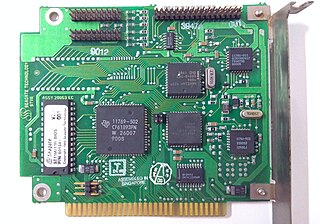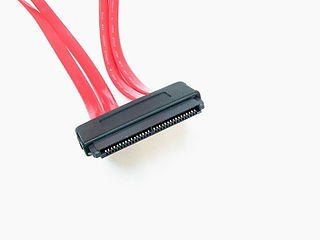
In computing, a device driver is a computer program that operates or controls a particular type of device that is attached to a computer or automaton. A driver provides a software interface to hardware devices, enabling operating systems and other computer programs to access hardware functions without needing to know precise details about the hardware being used.

Small Computer System Interface is a set of standards for physically connecting and transferring data between computers and peripheral devices, best known for its use with storage devices such as hard disk drives. SCSI was introduced in the 1980s and has seen widespread use on servers and high-end workstations, with new SCSI standards being published as recently as SAS-4 in 2017.
Internet Small Computer Systems Interface or iSCSI is an Internet Protocol-based storage networking standard for linking data storage facilities. iSCSI provides block-level access to storage devices by carrying SCSI commands over a TCP/IP network. iSCSI facilitates data transfers over intranets and to manage storage over long distances. It can be used to transmit data over local area networks (LANs), wide area networks (WANs), or the Internet and can enable location-independent data storage and retrieval.

The ST-506 and ST-412 were early hard disk drive products introduced by Seagate in 1980 and 1981 respectively, that later became construed as hard disk drive interfaces: the ST-506 disk interface and the ST-412 disk interface. Compared to the ST-506 precursor, the ST-412 implemented a refinement to the seek speed, and increased the drive capacity from 5 MB to 10 MB, but was otherwise highly similar.

The disk controller is the controller circuit which enables the CPU to communicate with a hard disk, floppy disk or other kind of disk drive. It also provides an interface between the disk drive and the bus connecting it to the rest of the system.

In computer hardware, a host controller, host adapter, or host bus adapter (HBA), connects a computer system bus, which acts as the host system, to other network and storage devices. The terms are primarily used to refer to devices for connecting SCSI, SAS, NVMe, Fibre Channel and SATA devices. Devices for connecting to FireWire, USB and other devices may also be called host controllers or host adapters.
A disk array controller is a device that manages the physical disk drives and presents them to the computer as logical units. It almost always implements hardware RAID, thus it is sometimes referred to as RAID controller. It also often provides additional disk cache.

A disk enclosure is a specialized casing designed to hold and power hard disk drives or solid state drives while providing a mechanism to allow them to communicate to one or more separate computers.
In computer storage, a logical unit number, or LUN, is a number used to identify a logical unit, which is a device addressed by the SCSI protocol or by Storage Area Network protocols that encapsulate SCSI, such as Fibre Channel or iSCSI.

In computing, Serial Attached SCSI (SAS) is a point-to-point serial protocol that moves data to and from computer-storage devices such as hard disk drives and tape drives. SAS replaces the older Parallel SCSI bus technology that first appeared in the mid-1980s. SAS, like its predecessor, uses the standard SCSI command set. SAS offers optional compatibility with Serial ATA (SATA), versions 2 and later. This allows the connection of SATA drives to most SAS backplanes or controllers. The reverse, connecting SAS drives to SATA backplanes, is not possible.
SCSI Enclosure Services (SES) is a protocol for more modern SCSI enclosure products. An initiator can communicate with the enclosure using a specialized set of SCSI commands to access power, cooling, and other non-data characteristics.
SCSI Enclosure Services (SES) devices contains a number of elements, each of which is defined by a one byte SCSI element code. There are many different element codes defined to cover various devices as shown in the list below.
A SCSI connector is used to connect computer parts that use a system called SCSI to communicate with each other. Generally, two connectors, designated male and female, plug together to form a connection which allows two components, such as a computer and a disk drive, to communicate with each other. SCSI connectors can be electrical connectors or optical connectors. There have been a large variety of SCSI connectors in use at one time or another in the computer industry. Twenty-five years of evolution and three major revisions of the standards resulted in requirements for Parallel SCSI connectors that could handle an 8, 16 or 32 bit wide bus running at 5, 10 or 20 megatransfer/s, with conventional or differential signaling. Serial SCSI added another three transport types, each with one or more connector types. Manufacturers have frequently chosen connectors based on factors of size, cost, or convenience at the expense of compatibility.

Parallel SCSI is the earliest of the interface implementations in the SCSI family. SPI is a parallel bus; there is one set of electrical connections stretching from one end of the SCSI bus to the other. A SCSI device attaches to the bus but does not interrupt it. Both ends of the bus must be terminated.
The Enclosure Services Interface (ESI) is a computer protocol used in SCSI enclosures. This is part of a chain of connections that allows a host computer to communicate with the enclosure to access its power, cooling, and other non-data characteristics. This overall approach is called SCSI attached enclosure services:
The introduction of Serial Attached SCSI (SAS) as the most recent evolution of SCSI required redefining the related standard for enclosure management, called SCSI Enclosure Services. SES-2, or SCSI Enclosure Management 2 first revision, was introduced in 2002 and is now at revision 20. SES-2 SCSI Enclosure Services (SES) permit the management and sense the state of power supplies, cooling devices, LED displays, indicators, individual drives, and other non-SCSI elements installed in an enclosure. SES2 alerts users about drive, temperature and fan failures with an audible alarm and a fan failure LED.
In computer storage, SAF-TE is an industry standard to interface an enclosure in-band to a (parallel) SCSI subsystem in order to gain access to information or control for various elements and parameters. These include temperature, fan status, slot status (populated/empty), door status, power supplies, alarms, and indicators. Practically, any given SAF-TE device will only support a subset of all possible sensors or controls.
EqualLogic, Inc. was an American computer data storage company based in Nashua, New Hampshire, active from 2001 to 2007. In 2008, the company was merged into Dell Inc. Dell-branded EqualLogic products are iSCSI-based storage area network (SAN) systems. Dell has 3 different lines of SAN products: EqualLogic, Compellent and Dell PowerVault.
IBM Storwize systems were virtualizing RAID computer data storage systems with raw storage capacities up to 32 PB. Storwize is based on the same software as IBM SAN Volume Controller (SVC).
The bio(4) pseudo-device driver and the bioctl(8) utility implement a generic RAID volume management interface in OpenBSD and NetBSD. The idea behind this software is similar to ifconfig, where a single utility from the operating system can be used to control any RAID controller using a generic interface, instead of having to rely on many proprietary and custom RAID management utilities specific for each given hardware RAID manufacturer. Features include monitoring of the health status of the arrays, controlling identification through blinking the LEDs and managing of sound alarms, and specifying hot spare disks. Additionally, the softraid configuration in OpenBSD is delegated to bioctl as well; whereas the initial creation of volumes and configuration of hardware RAID is left to card BIOS as non-essential after the operating system has already been booted. Interfacing between the kernel and userland is performed through the ioctl system call through the /dev/bio pseudo-device.







